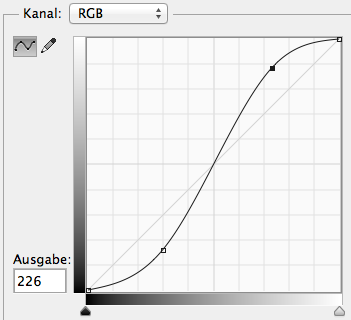


»Master-Curve« nennt man die Kurve, die alle drei bzw. vier Kanäle gleichzeitig bearbeitet.
Allerdings waren sich zu diesem Thema zwei prominente Photoshopper uneins. Die Rede ist von Autor Dan Margulis und niemand geringerem als Photoshop-Erfinder Thomas Knoll.
Dan Margulis war (oder ist) der Meinung, dass Gradationskurven im RGB-Farbraum den Farbton und die Sättigung eines Bildes zerstören. Er rät daher in diesem Zusammenhang zur Nutzung von LAB. Damit kann die Gradationskurve dann nur im L-Kanal angewandt werden, sodass Farbton und Sättigung unverändert bleiben.
Thomas Knoll meint allerdings, dass das Modifizieren des Kontrasts die Sättigung verändern soll. Dieses Thema wurde 2007 in vielen Foren wochenlang diskutiert und führt auch heute noch zu Diskussionen. Fakt ist, dass Thomas Knoll Master-Curve-Einstellungen so entwickelt hat, dass die Sättigung davon beeinflusst wird. Er sagte dazu einmal, dass es sogar einfacher wäre, Gradationskurven ohne diesen »saturation boost« zu programmieren, aber er hat sich dazu entschlossen, da dies in den meisten Fällen zu optisch ansprechenderen Ergebnissen führt.
But Lightroom/Camera Raw curves do work slightly differently from Photoshop curves and this is because Lightroom curves have a hue lock. This means that when Lightroom maps the RGB values from the before state to the Tone Curve state, it will map the minimum and maximum RGB values (in the linear Lightroom RGB workspace) allowing the hue to vary. But when mapping the middle RGB value, the hue is preserved. Photoshop curves meanwhile have no hue lock and therefore when you apply a strong curve adjustment in Photoshop the hue values can shift quite a bit from the original before values. This in turn can lead to some noticeable color shifts in the processed image. Lightroom/ACR curves do also produce hue shifts, but these are more tightly controlled so that what hue shifts there are, are usually within plus or minus 3°. As I said, Tone Curves in Lightroom that increase the contrast, will boost the saturation, but from the conclusions I draw later, Lightroom/ACR tone curves are on average about 1–2% less contrasty than curves that are applied via Photoshop in the Normal blend mode. In practice this means that Lightroom tone curve adjustments will have smaller hue shifts and the colors are represented better.